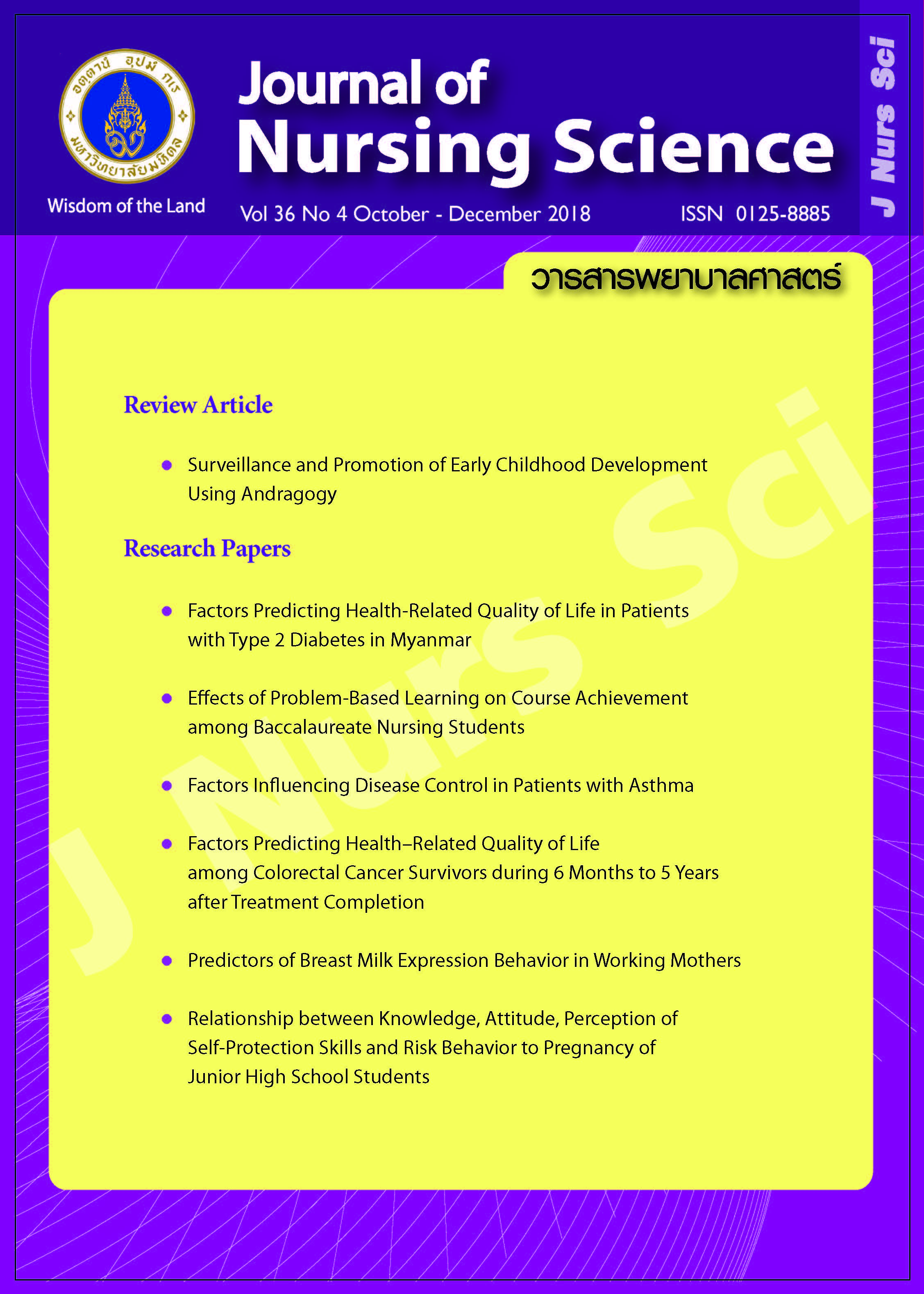Predictors of Breast Milk Expression Behavior in Working Mothers
Main Article Content
Abstract
Purpose: To examine the predictive power of perceived benefits of breast milk expression,
perceived barriers of breast milk expression, and perceived support from significant others on breast milk expression behavior in working mothers.
Design: Correlational predictive design.
Method: The study sample consisted of 78 mothers who brought their child aged 6 months or older to receive health supervision at Siriraj Hospital. Data were collected using the demographic data form, a set of questionnaires consisting of the Breast Milk Expression Behavior, the Perceived Benefits of Breast Milk Expression, the Perceived Barriers of Breast Milk Expression, and the Perceived Support from Significant Others on Breast Milk Expression. Data analysis was performed using multiple regression analysis.
Main findings: The study findings revealed that perceived benefits, perceived barriers, and
perceived support together could predict 36.5% of the variances explained in breast milk expression behavior of working mothers (R2 = .365). Perceived barriers was the most influential predictor of breast milk expression behavior (β = -.415, p < .01), followed by perceived support from significant others (β = .256, p < .01). However, perceived benefits could not predicted breast milk expression behavior of working mothers (β = .076, p = .52).
Conclusion and recommendations: Perceived barriers and supports from significant others
can influence breast milk expression behavior among working mothers. To promote breast milk expression among working mothers so that breastfeeding will continue, nursing interventions should focus on the mothers’ perceived barriers and the solutions to overcome these problems. Working mothers’ significant others should be also considered as a part of interventions.
Article Details
Copyright Notice: Nursing Science Journal of Thailand has exclusive rights to publish and distribute the manuscript and all contents therein. Without the journal’s permission, the dissemination of the manuscript in another journal or online, and the reproduction of the manuscript for non-educational purpose are prohibited.

Disclaimer: The opinion expressed and figures provided in this journal, NSJT, are the sole responsibility of the authors. The editorial board bears no responsibility in this regard.
References
2. World Health Organization (WHO). Breastfeeding policy: a globally comparative analysis. Geneva, Switzerland: WHO; 2013.
3. National Statistical Office, United Nations Children’s Fund. Thailand multiple indicator cluster survey 2015-2016: final report. Bangkok: NSO and UNICEF; 2016. (in Thai).
4. Olang B, Heidarzadeh A, Strandvik B, Yngve A. Reasons given by mothers for discontinuing breastfeeding in lran. Int Breastfeed J. 2012;7(1):7. doi: 10.1186/1746-4358-7-7.
5. Win NN, Binns CW, Zhao Y, Scott JA, Oddy WH. Breastfeeding duration in mother who express breast milk: a cohort study. Int Breastfeed J. 2006;1:28. doi: 10.1186/1746-4358-1-28.
6. Becker GE, Smith HA, Cooney F. Methods of expression for lactating women. Cochrane Database of Syst Rev. 2016 Sep 29;9:CD006170. doi: 10.1002/14651858. CD006170.pub5. PubMed PMID: 27684560.
7. Ortiz J, McGilligan K, Kelly P. Duration of breast milk expression among working mothers enrolled in an employer sponsored lactation program. Pediatr Nurs. 2004;30(2):111-9.
8. Ratanasongkram P. Predictors of milk expression behavior in mothers of premature infants [master’s thesis]. Bangkok: Chulalongkorn University; 2016. 130 p. (in Thai).
9. Labiner-Wolfe J, Fein SB, Shealy KR, Wang C. Prevalence of breast milk expression and associated factors. Pediatrics. 2008;12 Suppl 2:S63-8.
10. Geraghty S, Davidson B, Tabangin M, Morrow A. Predictors of breastmilk expression by 1 month postpartum and influence on breastmilk feeding duration. Breastfeed Med. 2012;7(2):112-7.
11. Chisuwan C, Prasopkitikun T, Sangperm P, Payakkaraung S. Predictive power of support from husbands, grandmothers, and nurses on duration of exclusive breastfeeding. Journal of Nursing Science. 2012;30(1):70-80. (in Thai).
12. Pender NJ, Murdaugh CL, Parson MA. Health promotion in nursing practice. 5th ed. Englewood Cliffs, NJ: Prentice Hall; 2007.
13. Tsai SY. Employee perception of breastfeeding-friendly support and benefit of breastfeeding as a predictor of intention to use breast-pumping breaks after returning to work among employed mothers. Breastfeed Med. 2014;9(1):16-23.
14. Polit DF, Beck CT. Nursing research: generating and assessing evidence for nursing practice. 9th ed. Philadelphia, PA: Lippincott Williams & Wilkins; 2012. p.425.
15. Eglash A, Malloy ML. Breastmilk expression and breast pump technology. Clin Obstat Gynecol. 2015;58(4):855-67.
16. Tsai SY. Impact of breastfeeding-friendly workplace on an employed mother’s intention to continue breastfeeding after returning to work. Breastfeed Med. 2013;8:210-6.
17. Clemons N, Amir H. Breastfeeding women’s experience of expressing: a descriptive study. J Hum Lact. 2010;26(3):258-65.
18. Office of the Council of State. Key finding: labour protect act B.E. 2541 [Internet]. Bangkok: Office of the Council of State, Thailand; 2010 [cited 2018 Apr 23]. Available from: http://web.krisdika.go.th/data/law/law2/%a477/%a477-20-2560-a0003.pdf. (in Thai).
19. Chen PG, Johnson LW, Rosenthal MS. Sources of education about breastfeeding and breast pump use: what effect do they have on breastfeeding duration? An analysis of infant feeding practices survey II. Matern Child Health J. 2012;16(7):1421-30.
20. Tsai SY. Influence of partner support on an employed mother’s intention to breastfeed after returning to work. Breastfeed Med. 2014;9(4):222-30.
21. Yuangthong S, Sawatphanit W, Deoisres W. The effect of breastfeeding promoting program for first-time postpartum mothers on breastfeeding duration and behaviors. The Public Health Journal of Burapha University. 2012;7(2):100-15. (in Thai).
22. Boonchalerm P, Prasopkittikun T, Sangperm P, Jirasakuldej W. Effects of the mother-preterm infant preparation program on breastfeeding self-efficacy and sucking quality. Journal of Nursing Science. 2012;30(4):61-71. (in Thai).
23. Mclnnes RJ, Arbuckle A, Hoddinott P. How UK internet websites portray breast milk expression and breast pump: A qualitative study of content. BMC Pregnancy Childbirth. 2015 Apr 2;15:81. doi:10.1186/s12884-015-0509-0.

